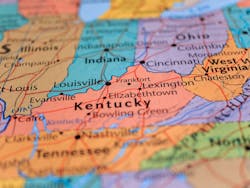Kentucky has 558 ideal sites for nanogrids and a dozen potential sites for regional community microgrids, according to a state study that aims to spur microgrid development at critical facilities in response to the growing threat of power outages.
The Kentucky Regional Microgrids for Resilience Study was designed to help utilities, local and state governments, and industry stakeholders move from planning microgrids to building them.
“We continue our efforts to respond to the rapidly changing energy landscape,” Kenya Stump, Kentucky Office of Energy Policy executive director, said May 6. “This collaborative project has helped our communities explore how they can better assess their energy vulnerabilities, specifically how to assess their critical facility power outage vulnerabilities and how they can plan and identify power sector mitigation activities.”
By Alexander Lukatskiy/Shutterstock.com
Communities can use the study to help access federal funding and pave the way for public-private partnerships to deploy microgrids, Stump said.
Potential nanogrids would cover individual facilities such as hospitals, nursing homes, water treatment plants, fire stations, grocery stores and cell towers, according to the Smart Electric Power Alliance (SEPA), the nonprofit education and research organization that conducted the study.
Costs rising from weather damage
Like other states, Kentucky has been hit by an increasing number of extreme weather events. Since 2000, Kentucky has experienced 43 extreme weather events, leading to $500 million to $1 billion in annual costs, compared with 20 extreme weather events costing $250 million to $500 million a year in the previous 20 years, according to the study.
Power outages are a major contributor to the economic losses, SEPA said in the study.
Study finds ideal microgrid sites
The study evaluated 6,640 critical infrastructure facilities for potential microgrids. The SEPA analysts used two main criteria for identifying the state’s best microgrid sites.
First, the analysts identified microgrid sites that can support the grid where it is needed most while avoiding high-risk areas, such as places prone to tornadoes, which could destroy a microgrid.
Second, they wanted to make sure that highly populated areas and underserved communities have access to essential services during power outages.
Microgrid 2021: The World Awakens to Microgrids begins this week! Registration is free if done in advance. To attend a session, it is necessary to register at least one day in advance of the session.
The study identified 110 gas stations, 90 fire stations, 70 grocery stores, 56 communication towers and 50 wastewater treatment plants as ideal nanogrid sites. Other types of facilities that were identified included water treatment plants, law enforcement buildings, emergency operations centers, nursing homes, hospitals and national defense facilities.
There are 12 potential community microgrid sites scattered around the state that would cover multiple facilities. The study, for example, identified a potential microgrid site in Springfield, Kentucky, that could serve a cell tower, an emergency operations center, a fire station, a gas station, a grocery store, a law enforcement facility, a wastewater treatment plant and a water treatment plant.
Microgrid cost estimates
The report includes rough cost estimates for setting up microgrids based on the type of facility they would cover. The Springfield microgrid would cost up to $106,000 if it was based on backup generators, not including operating and maintenance expenses or the cost of grid upgrades, according to the report. If the backup generators were supplemented with renewable energy and battery storage, the microgrid could cost up to $1.4 million, the SEPA analysts said.
The analysts also estimated the costs for nanogrids based on the typical load from the different types of facilities that would host the nanogrids.
A nanogrid at a grocery story using a 35-kW backup generator would cost $12,000 to $19,000, not including operating and maintenance expenses, according to the study. If the microgrid included a 30-kW standby generator, 5 kW of battery storage and 39 kW of rooftop solar, it would cost $153,000 to $177,000.
SEPA said one of the lessons from the study is that evaluating microgrids by looking at the problems they solve and the services they provide is a key step in understanding where they can provide the most resilience value.
The study also highlights the importance of conducting a coordinated planning effort across stakeholder organizations and entities, SEPA said.
Track news about nanogrids and microgrids. Subscribe to the free Microgrid Knowledge Newsletter.







